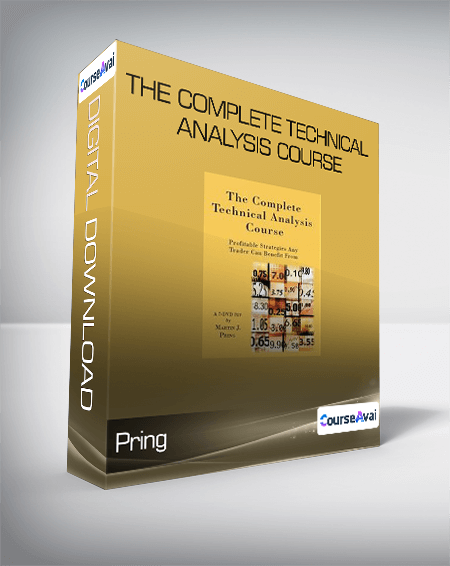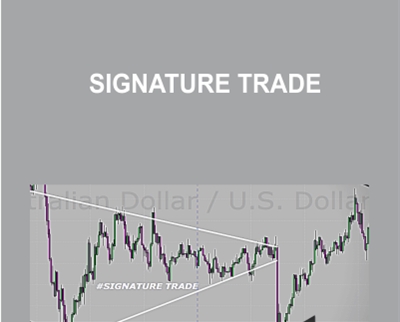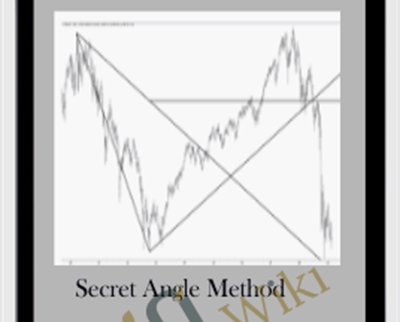Martin Pring – The Complete Technical Analysis Course
Original price was: $399.00.$42.00Current price is: $42.00.
Salepage link: At HERE. Archive:
Pring – The Complete Technical Analysis Course
Get Pring – The Complete Technical Analysis Course at the CourseAvai
The Complete Technical Analysis Course
Lesson 1 – The Building Blocks of Technical Analysis
This presentation is a basic introduction for anyone new to the fascinating subject of technical analysis.
Technical Analysis – What it is. Why prices are determined by psychology and how technical analysis can help interpret market psychology.
Trends – What is a trend? How long do they last? How do they integrate?
Arithmetic vs. Logarithmic Scaling – Technical analysis requires charts and the choice of scaling them can be very important. This section explains the difference between these techniques and why one is superior over the other.
Volume – Observations on volume interpretation.
Peak and Trough Analysis – Why it’s probably the most important technical tool. How is it applied in the market place and integrated with other indicators.
Support and Resistance – The concepts defined. Rules for determining where potential support and resistance areas might lie are given along with guidelines for determining their potential significance.
Trendlines – A to Z introductory primmer on trendlines, how to draw and interpret them.
Price Patterns – Basic principles of price pattern interpretation using rectangles and head and shoulders patterns as examples. Determining the significance of individual patterns and identifying when they have failed is also covered.
Lesson 2 – Introduction to Classic Price Patterns
This session introduces you to the most common price patterns. Building on the knowledge leaned from the previous DVD, you will be in a better position to understand how patterns are formed and the psychology behind them.
If you can rationalize why a pattern is being formed, you will be in a better position to anticipate when a breakout might turn out to be a whipsaw, and how you can protect against this. This session also explains how price objectives are determined from patterns. A large number of market place examples in all time frames is generously dispersed throughout the presentation. The individual formations covered are:
Rectangles
Head and shoulders tops and bottoms
Triangles
Double tops and bottoms and triple formations, including Chinese and Lucky Seven double bottoms.
Broadening formations, broadening wedges and giant wedges
Cup and Handle formations
Lesson 3 – One- and Two-bar Price Patterns
Prices in any freely traded market are determined by psychology. One- and two-bar price patterns represent classic examples of how these emotional characteristics are reflected in the charts.
The great advantage of these extremely reliable patterns is that they signal reversals in trend at a very early stage, both on the intraday and daily charts.
The presentation also explains that not all patterns are created equal. Pring gives you a checklist for determining the significance of each type.
Patterns covered include:
Outside bars
Inside bars
Two-bar reversals
Exhaustion bars
Key-bar reversals
Pinocchio bars
Three-bar reversals
Lesson 4 – Introduction to Basic Momentum Principles
Market momentum provides a powerful dynamic to any trading arsenal. In this presentation Martin Pring explains that momentum is a generic term embracing a host of oscillators. Each is subject to the same rules of interpretation in some form or another. Key techniques are explained in detail.
They are:
Overbought / oversold
Divergences
Oscillator characteristics in bull and bear markets
Trendlines applied to momentum
Price patterns applied to momentum
Moving averages applied to momentum
Individual oscillators that are explained include the rate-of-change, RSI, and MACD. Practical application of these indicators is demonstrated with a host of market place examples.
Lesson 5 – Introducing the KST
The KST is a momentum indicator invented by Martin Pring. It is a summed rate of change that combines several time spans into one indicator. It is designed so that the oscillations correctly reflect the up and down waves of the trend being monitored. However, the inclusion of short-term time frames in the indicator’s construction allow it to turn more quickly than many other indicators, thereby warning of a trend reversal on a more timely basis. Topics covered include:
The Rationale
The Long-term KST (primary trend)
The Short (daily) and Intermediate (weekly) KSTs
Integrating the Three Trends
The Intraday KST
Using the KST with Relative Strength
Oh, and you’ll also find out what KST stands for and find the various formulas, including those for MetaStock users in the downloadable .PDF file included on the presentation.
Lesson 6 – Applying Technical Analysis to the Theory of Contrary Opinion
In recent years, the theory of Contrary Opinion has become very popular, but also misunderstood. In this presentation Martin explains why this is so, and how this art can be profitably applied to the marketplace. He takes you through a step-by-step process of how to form a contrary opinion. He also demonstrates why it is difficult to take a contrary position and how to overcome this hurdle.
Going against the crowd is usually the correct thing to do, but it can be frustratingly (and unprofitably) early, as many bears found out to their chagrin in 1927 and 1928. Since charts reflect crowd psychology, technicians are in a unique position to utilize the art of contrary thinking and create razor sharp timing. A key part of this presentation explains techniques for integrating the two. This presentation wraps up by describing, and debasing, seven popularly held market myths.
Lesson 7 – Practical Trading Tactics Applied to the Marketplace
Lots of time is spent on learning the principles of technical analysis, but precious little is devoted it its practical application in the marketplace. In this presentation Martin shows you numerous techniques that you can apply for more profitable trading.
He sets out by explaining, with the aid of examples, why the first objective of any trader should be to avoid major losses, rather than trying to make major gains.
One technique for achieving this goal is the correct placement of stops below support and above resistance. Rules for assessing potential support/resistance zones are discussed using the following technical tools –
Gaps
Emotional Points
Trendlines
Moving Averages
Retracement moves
Previous highs and lows
Technicians would love to know ahead of time whether the market they are trading is likely to trend or become a trading range. Unfortunately, this is not possible. However, Martin explains a trading plan that can deals profitably with both environments.
Finally, since the biggest obstacle to any trader is emotion, Martin offers ten tips to better overcome your natural tendencies and become a more objective trader.
Get Pring – The Complete Technical Analysis Course at the CourseAvai
Sale Page :http://www.pring.com/products/taecourse.htm
Here's an overview of the prominent keywords and a list of famous authors:
Business and Sales: Explore business strategies, sales skills, entrepreneurship, and brand-building from authors like Joe Wicks, Jillian Michaels, and Tony Horton.
Sports and Fitness: Enhance athleticism, improve health and fitness with guidance from experts like Shaun T, Kayla Itsines, and Yoga with Adriene.
Personal Development: Develop communication skills, time management, creative thinking, and enhance self-awareness from authors like Gretchen Rubin, Simon Sinek, and Marie Kondo.
Technology and Coding: Learn about artificial intelligence, data analytics, programming, and blockchain technology from thought leaders like Neil deGrasse Tyson, Amy Cuddy, and Malcolm Gladwell.
Lifestyle and Wellness: Discover courses on holistic health, yoga, and healthy living from authors like Elizabeth Gilbert, Bill Nye, and Tracy Anderson.
Art and Creativity: Explore the world of art, creativity, and painting with guidance from renowned artists like Bob Ross and others.
All the courses on WSOlib are led by top authors and experts in their respective fields. Rest assured that the knowledge and skills you acquire are reliable and highly applicable.
Specification: Martin Pring – The Complete Technical Analysis Course
|
User Reviews
Only logged in customers who have purchased this product may leave a review.

Original price was: $399.00.$42.00Current price is: $42.00.












There are no reviews yet.